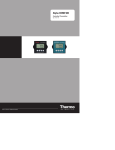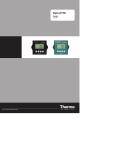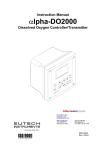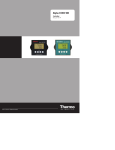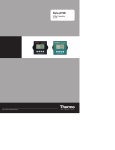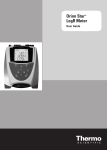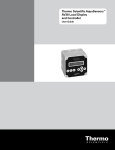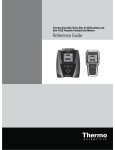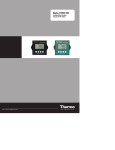Download EUTECH INSTRUMENTS ?lpha-pH500 Specifications
Transcript
Alpha DO 500 Transmitter Dissolved Oxygen ROSS and the COIL trade dress are trademarks of Thermo Fisher Scientific Inc. U.S. patent 6,793,787. AQUAfast, Cahn, ionplus, KNIpHE, No Cal, ORION, perpHect, PerpHecT, PerpHecTion, pHISA, pHuture, Pure Water, Sage, Sensing the Future, SensorLink, ROSS, ROSS Ultra, Sure-Flow, Titrator PLUS and TURBO2 are registered trademarks of Thermo Fisher. 1-888-pHAX-ION, A+, All in One, Aplus, AQUAsnap, AssuredAccuracy, AUTO-BAR, AUTOCAL, AUTO DISPENSER, Auto-ID, AUTO-LOG, AUTO-READ, AUTO-STIR, Auto-Test, BOD AutoEZ, Cable-Free, CERTI-CAL, CISA, DataCOLLECT, DataPLUS, digital LogR, DirectCal, DuraProbe, Environmental Product Authority, Extra Easy/Extra Value, FAST QC, GAP, GLPcal, GLPcheck, GLPdoc, ISEasy, KAP, LabConnect, LogR, Low Maintenance Triode, Minimum Stir Requirement, MSR, NISS, One-Touch, One-Touch Calibration, One-Touch Measurement, Optimum Results, Orion Star, Pentrode, pHuture MMS, pHuture Pentrode, pHuture Quatrode, pHuture Triode, Quatrode, QuiKcheK, rf link, ROSS Resolution, SAOB, SMART AVERAGING, Smart CheK, SMART STABILITY, Stacked, Star Navigator 21, Stat Face, The Enhanced Lab, ThermaSense, Triode, TRIUMpH, Unbreakable pH, Universal Access are trademarks of Thermo Fisher. Guaranteed Success and The Technical Edge are service marks of Thermo Fisher. PerpHecT meters are protected by U.S. patent 6,168,707. PerpHecT ROSS electrodes are protected by U.S. patent 6,168,707. ORION Series A meters and 900A printer are protected by U.S. patents 5,198,093, D334,208 and D346,753.ionplus electrodes and Optimum Results solutions are protected by U.S. patent 5,830,338.ROSS Ultra electrodes are protected by U.S. patent 6,793,787.ORP standard is protected by U.S. patent 6,350,367. No Cal electrodes are protected by U.S. patent 7,276,142.© 2009 Thermo Fisher Scientific Inc. All rights reserved. All trademarks are the property of Thermo Fisher Scientific Inc. and its subsidiaries.The specifications, descriptions, drawings, ordering information and part numbers within this document are subject to change without notice.This publication supersedes all previous publications on this subject. Preface This manual serves to explain the use of the Alpha DO 500 transmitter. It functions in two ways, firstly as a step by step guide to help you to operate the transmitter. Secondly, it serves as a handy reference guide. It is written to cover as many anticipated applications of the transmitter as possible. If there are doubts in the use of the transmitter, please do not hesitate to contact the nearest Authorized Distributor. Thermo Scientific will not accept any responsibility for damage or malfunction to the transmitter caused by improper use of the instrument. Remember to fill in the guarantee card and mail it back to your authorized distributor. The information presented in this manual is subject to change without notice as improvements are made, and does not represent a commitment on the part of Thermo Scientific. Copyright 2009 All rights reserved. Table of Contents 1. Introduction ...........................................................................................................1 1.1 1.2 1.3 1.4 Before You Begin ................................................................................................................... 1 Intended Use .......................................................................................................................... 1 Safety Instructions.................................................................................................................. 2 Taking Out of Service / Correct Disposal of the Unit ............................................................. 2 2. Getting Started ......................................................................................................3 2.1 Description of Instrument ....................................................................................................... 3 Power Supply Requirements (SL2 Position) ................................................................................... 3 2.2 Measurement and Control System......................................................................................... 4 2.3 Connecting Peripherals.......................................................................................................... 5 2.3.1 Connection Terminals.................................................................................................... 5 2.3.2 Connecting Dissolved Oxygen Electrode ...................................................................... 6 2.3.3 Connecting Temperature Probe .................................................................................... 6 2.4 Installation .............................................................................................................................. 7 2.4.1 Mechanical Dimensions................................................................................................. 7 2.4.2 Wall Mount..................................................................................................................... 7 2.4.3 Panel Mount................................................................................................................... 8 2.5 Display & Keypad ................................................................................................................... 9 2.5.1 Display Overview........................................................................................................... 9 2.5.2 Key Functions .............................................................................................................. 10 3. Normal Operation ................................................................................................11 3.1 3.2 Measurement mode ............................................................................................................. 11 Menu Overview .................................................................................................................... 12 4. Calibration Mode .................................................................................................13 4.1 4.2 4.3 Entering Calibration Mode.................................................................................................... 13 Calibration in mg/l or ppm of Oxygen................................................................................... 14 4.2.1 1-Point Calibration ....................................................................................................... 14 4.2.2 2-Point Calibration ....................................................................................................... 15 Calibration in% Saturation of Oxygen .................................................................................. 17 4.3.1 1-Point Calibration ....................................................................................................... 17 4.3.2 2-Point Calibration: ...................................................................................................... 18 5. Setup Mode ..........................................................................................................20 5.1 5.2 5.3 5.4 5.5 5.6 5.7 5.8 5.9 5.10 Enter Setup mode ................................................................................................................ 20 Configuration Settings .......................................................................................................... 21 Offset Settings...................................................................................................................... 23 Temperature Settings........................................................................................................... 25 Range Settings..................................................................................................................... 27 Hold Settings ........................................................................................................................ 28 Out of Range Settings .......................................................................................................... 29 Viewing Calibration Point ..................................................................................................... 30 Viewing Electrode Condition ................................................................................................ 31 Resetting .............................................................................................................................. 32 6. Technical Specifications.....................................................................................33 7. List of Accessories .............................................................................................35 7.1 7.2 Thermo Scientific.................................................................................................................. 35 Eutech Instruments .............................................................................................................. 36 8. Troubleshooting ..................................................................................................37 9. General Information ............................................................................................38 9.1 9.2 9.3 9.4 Warranty............................................................................................................................... 38 Return of Goods ................................................................................................................... 38 Guidelines for Returning Unit for Repair .............................................................................. 38 Maintenance and Cleaning .................................................................................................. 38 10. Appendices .......................................................................................................39 10.1 Appendix 1 – Salinity vs. Temperature (@ 760mmHg)........................................................ 39 10.2 Appendix 2 – Abbreviations Used in LCD ............................................................................ 40 Instruction Manual Alpha DO 500 1. Introduction 1.1 Before You Begin We thank you for purchasing the Alpha DO 500 Transmitter. The construction of the Alpha DO 500 Transmitter employs leading edge technology and complies with safety regulations currently in force. Notwithstanding this, improper use could lead to hazards for the user or a third-party, and/or adverse effects on the plant or other equipment. Therefore, the operating instructions must be read and understood by the persons involved before work is started with the Alpha DO 500 Transmitter. The instruction manual must always be stored close at hand, in a place accessible to all people working with the Alpha DO 500 Transmitter. If you have questions, which are not or insufficiently answered in this instruction manual, please contact your authorized supplier. They will be glad to assist you. 1.2 Intended Use Alpha DO 500 Transmitters are intended solely for dissolved oxygen (DO) and temperature measurement, as described in this instruction manual. Any other use, or use not mentioned here, that is incompatible with the technical specifications is deemed inappropriate. The operator is solely responsible for any damage arising from such use. Other prerequisites for appropriate use include: – Comply with the instructions, notes and requirements set out in this instruction manual. – Comply with all local safety regulations concerning safety at work. – Comply with all information and warnings in the documentation dealing with the products used together with the Alpha DO 500 Transmitter (housings, sensors, etc.). – Comply with local environmental and operational conditions. 1 Instruction Manual Alpha DO 500 1.3 Safety Instructions - The Alpha DO 500 Transmitter should be installed and operated only by personnel familiar with the instrument and who are qualified for such work. - A defective Transmitter must neither be installed nor put into service. - The Alpha DO 500 Transmitter must only be operated under the specified operating conditions (see section 5.9). - The Alpha DO 500 Transmitter must not be repaired by the customer. - No modifications to the Alpha DO 500 Transmitter are allowed. The manufacturer/supplier accepts no responsibility for damage caused by unauthorized modifications. The risk is borne entirely by the user. 1.4 Taking Out of Service / Correct Disposal of the Unit Taking out of Service x First disconnect the unit from the power supply and then undo all electrical connections. x Remove the unit from the wall / panel. Correct Disposal of the Instrument When the DO Transmitter is permanently taken out of service, obey the local environmental regulations for correct disposal or send the instrument to your local distributor, they will take care of proper disposal. 2 Instruction Manual Alpha DO 500 2. Getting Started 2.1 Description of Instrument The Thermo Scientific Alpha DO 500 Transmitter is used for measuring dissolved oxygen and temperature values. The dissolved oxygen values can be measured using industrial dissolved oxygen sensors. The temperature values can be measured using 2-wire or 3-wire Pt100 sensors. The DO Transmitter can be used for applications such as water treatment and monitoring, galvanic-decontamination, chemical processing, food processing, clean or wastewater control and neutralization processes. The Alpha DO 500 Transmitter has many user-friendly and safety features which include: x Push-button keypad for calibration and setup x Built-in non-volatile memory to ensure that calibration and other information are not erased if power supply fails x Menu-driven program that simplifies setup x Automatic temperature compensation (ATC) x Manual temperature compensation setting without the ATC probe, with independent setting for calibration and process temperature x Large dual display LCD for easy reading with clear multiple annunciators, operational mode indicators and error indicators. x Galvanically isolated current output of 4 to 20mA x Hold function to freeze output current (22mA) x Out of range current indication (3.8mA) x Protection against electromagnetic interference Power Supply Requirements (SL2 Position) This transmitter requires a 12 to 24V DC power supply. Other Transmitters and/or a chart recorder may be connected in series. 1. Insert positive loop wire from power supply to pin 1, tighten screw. 2. Insert negative loop wire to pin 2, tighten screw. This wire may be linked to a chart recorder or to negative terminal of power supply. 1 Power Supply Alpha pH500 2 Chart recorder 3 Instruction Manual Alpha DO 500 2.2 Measurement and Control System A typical measurement system consists of: x A Alpha DO 500 Transmitter x A dissolved oxygen sensor with integrated or separate Pt100 temperature sensor x An appropriate measurement cable x An immersion, flow or process assembly x A chart recorder Alpha DO500 Transmitter Chart Recorder Alpha DO500 ESC CAL ENT 2-wire Dissolved Oxygen Transmitter 4 - 20 mA Housing and Sensors Measurement Cable 4 Power Adaptor (12 to 24 V DC) Instruction Manual Alpha DO 500 2.3 Connecting Peripherals 2.3.1 Connection Terminals Remove Back Cover: Remove the screws from the four corners at the back of the DO Transmitter. Remove the back cover. The connectors are exposed on the back PCBA as shown in the Figure 1 below. Connectors: x SL2 – 12 to 24 V DC power x SL1 – Dissolved Oxygen electrode & Temperature probe connections (wiring has to be done in the detachable connector SL2 SL1 Figure 1: Outer Side of Back PCBA SL1 Connections SL 2 Connections 1. DC Power Supply +ve terminal 2. DC Power Supply –ve terminal 3. No Connection 1. DO Input, +ve terminal 2. DO Input, -ve terminal 3. No Connection 4. No Connection 5. PT100 Compensate (Short to pin 6 for 2-wire RTD) 6. PT100 Sense 7. PT100 Ground 8. No Connection 5 Instruction Manual Alpha DO 500 2.3.2 Connecting Dissolved Oxygen Electrode Refer the instruction sheet that comes with your Dissolve Oxygen electrode to identify polarity (+ve and –ve) of DO wires. 1. Connect DO +ve wire to Pin 1 of SL1 connector 2. Connect DO -ve wire to Pin 2 of SL1 connector 2.3.3 Connecting Temperature Probe For Automatic Temperature Compensated (ATC) readings, a 100: Pt RTD temperature probe (2-wire or 3-wire) can be connected to the Transmitter. 3-Wire Probe: 1. Connect PT100 compensate wire to Pin 5 of SL1 connector 2. Connect PT100 sense wire to Pin 6 of SL1 connector 3. Connect PT100 GND wire to Pin 7 of SL1 connector 2-Wire Probe: 1. Short Pin 5 & 6 of SL1 connector using a small piece of wire. 2. Connect PT100 sense wire to Pin 6 of SL1 connector 3. Connect PT100 GND wire to Pin 7 of SL1 connector 6 Instruction Manual Alpha DO 500 2.4 Installation 2.4.1 Mechanical Dimensions Alpha DO 500 ESC CAL ENT 2-wire Dissolved Oxygen Transmitter 2.4.2 Wall Mount 1 2 Pierce through holes at both sides Cover the catch slots at both sides with overlays 7 Instruction Manual Alpha DO 500 2.4.3 Panel Mount 1 Prepare panel cut-out of 92.0 mm X 92.0 mm 2 Remove back cover of DO Transmitter and slide it through panel cut-out Gasket Panel Panel 4 Insert threaded rods through catch until DO Transmitter is held against panel 3 Attach catch to both sides of DO Transmitter 8 Instruction Manual Alpha DO 500 2.5 Display & Keypad 2.5.1 Display Overview The Liquid Crystal Display (LCD) of the Alpha DO 500 Transmitter has two alpha-numerical displays (Upper and a Lower). x Upper display: Measured dissolved oxygen reading (in % saturation or ppm or mg/l) is displayed when the Transmitter is in normal operation (measurement) mode. x Lower display: Measured temperature value is displayed when the Transmitter is in normal operation (measurement) mode. In Calibration mode, calibration points are displayed here. The two displays indicate function names, options & settings in Setup mode. Refer ‘Appendix 2 – Abbreviations Used in LCD’ for more details. The LCD also consists of various mode indicators, status annunciators and unit of measurement indicators. Upper Display SETUP MEAS CAL - % READY HOLD ppm mg/l K= - °C ERR ATC Lower Display Mode Indicators MEAS Measurement mode (Refer Section 3.1) SETUP Setup mode (Refer Section 5) CAL Calibration mode (Refer Section 4) Status Annunciators READY Appears when the reading is stable HOLD Appears in Setup mode and Calibration mode to indicate that the relay function is frozen ATC Appears when Automatic Temperature Compensation (ATC) is enabled. Not visible when Manual Temperature Compensation (MTC) is enabled. Flashes if the temperature probe is faulty in its ATC mode. (Refer Section 5.4) ERR Appears when an error occurs Buffer annunciator. Appears in calibration mode or viewing calibrated point Electrode annunciator. Appears when viewing electrode properties or during calibration error 9 Instruction Manual Alpha DO 500 Units of Measurement Indicators % Dissolved Oxygen in Percentage Saturation ppm Dissolved Oxygen in Parts Per Million mg/l Dissolved Oxygen in milligram per liter ºC Temperature in Celsius (Refer Section5.4) 2.5.2 Key Functions lpha DO500 ESC CAL ENT 2-wire Dissolved Oxygen Transmitter Key CAL Description Enter Calibration mode Enter Setup mode. ENT Access sub screens (parameters) within a group of settings in Setup mode. Confirm (save) setup parameters and numerical values Start/Confirm calibration in Calibration mode. Select a group of settings in Setup mode. Select parameters and increment/decrement numerical values in Setup and Calibration modes. (When pressed continuously, speed of values increment/decrement increases) Returns to Measurement mode when both keys are pressed simultaneously. 10 Instruction Manual Alpha DO 500 3. Normal Operation 3.1 Measurement mode When the DO Transmitter is powered on, the display shows all the LCD segments briefly, and then automatically enters into the Measurement mode. MEAS READY 99.0 25.0 % °C ATC The mode indicator ‘MEAS’ at the top of the display indicates that the Transmitter is in Measurement mode. The upper alpha-numerical display shows the measured dissolved oxygen value, while the lower display shows the temperature value. The indicator “%”, “ppm” or “mg/l” at the upper right side of the display indicates the current measurement mode. (Refer section 5.2 for switching measurement modes) NOTE: To guarantee accurate readings, the measuring system (the DO Transmitter and the sensor) must be calibrated regularly. From measurement mode you can access: x Calibration mode (by pressing CAL key) x Setup mode (by pressing ENT key) For more details, refer section 4 for Calibration mode and section 5 for Setup mode.) 11 Instruction Manual Alpha DO 500 3.2 Menu Overview CAL CAL ENT ENT ENT ENT ENT ENT ENT ENT ENT ENT ENT ENT ENT ENT ENT ENT ENT ENT ENT ENT HOLD MEAS % READY °C ATC SETUP HOLD ENT SETUP HOLD SETUP HOLD SETUP HOLD SETUP HOLD SETUP HOLD SETUP HOLD SETUP HOLD SETUP HOLD 12 Instruction Manual Alpha DO 500 4. Calibration Mode 4.1 Entering Calibration Mode While in measurement mode, press CAL key to access calibration mode. LCD indicates ‘CAL dO’. MEAS CAL % READY CAL ENT HOLD °C ATC To quit Calibration Mode Calibration Mode Calibration in mg/l or ppm - See Section 4.3 Calibration in % saturation - See Section 4.4 & NOTES: x To exit calibration mode at any time during calibration, press and keys simultaneously (escape). The DO Transmitter returns to the measurement mode and the old calibration values remain active. x The calibration is always carried out in the units of measurement (mg/l or ppm or %) selected in setup mode. 13 Instruction Manual Alpha DO 500 4.2 Calibration in mg/l or ppm of Oxygen The DO Transmitter is capable of calibration of up to 2 points for dissolved oxygen. All new calibration values will automatically override existing calibration data. Make sure the unit of measurement is set to mg/l or ppm. (Refer Section 5.2 for switching unit of measurements). If you wish to abort the DO calibration, press and keys simultaneously and the DO Transmitter reverts to measurement mode. 4.2.1 1-Point Calibration The 1-point calibration is done at high-point using 8.24 mg/l of dissolved oxygen solution. CAL 1 CAL HOLD 3 2 ENT CAL ENT HOLD HOLD 4 MEAS ENT READY READY mg/l mg/l °C ATC Measured value should be within +/- 50 % of high-point CAL + 22 CAL HOLD HOLD mg/l ERR Calibration error occurs if measured value is not within +/- 50% of high-point during 1-point calibration 1 From measurement mode press CAL key to enter calibration mode as described in section 4.1. The LCD shows ‘CAL Do’. Press ENT key to begin calibration. 2 Select 1-point calibration: The display shows ‘1Pt CAL’. If ‘2Pt CAL’ is shown, press or key to select ‘1Pt CAL’. Press ENT key to confirm the selection. 3 The buffer annunciator appears in LCD. The lower display shows ‘HI’, indicating the high-point is being calibrated. Immerse the electrode in 8.24 mg/l dissolved oxygen solution. Immerse the temperature probe in the solution if ATC is enabled. The upper display shows the measured value of dissolved oxygen of the solution. Allow the reading to stabilize. LCD shows ‘READY’ annunciator when the reading is stable. Press or key to adjust the reading to 8.24 mg/l. The Transmitter allows adjusting up to r50% of the measured value. Press ENT key to confirm the reading. NOTE: The transmitter does not accept the calibration and shows calibration error if the displayed (measured) value is more than r50% of the high-point value. 4 The calibration is completed. The DO Transmitter reverts to measurement mode. 14 Instruction Manual Alpha DO 500 NOTES: x If the displayed value is more than r10% of the high-point value, the Transmitter indicates a calibration error by showing ‘ERR’ and blinking electrode annunciator. If this happens, press and keys together to return to measurement mode. Restart the calibration from Step1. x x To exit from calibration mode without confirming calibration, press and keys together. When calibrating with manual temperature compensation, the Transmitter automatically changes from preset ‘process temperature’ to ‘calibration temperature’. After leaving calibration mode, the transmitter switches back to the ‘process temperature’. (Refer section 5.4 for temperature settings) 4.2.2 2-Point Calibration The 2-point calibration is carried out at Low-point (zero dissolved oxygen solution) and then at high-point using 8.24 mg/l of dissolved oxygen solution. CAL 1 CAL 2 CAL ENT HOLD 4 HOLD HOLD 5 MEAS ENT READY READY mg/l mg/l °C ATC + ENT CAL 22 3 CAL ENT HOLD ENT READY HOLD CAL mg/l HOLD mg/l ERR Measured value should be <10 % of high-point Calibration error occurs if measured value is <10% of high-point during 1st point calibration or if measured value is not within +/-50% of high-point during 2nd point calibration 1 From measurement mode press CAL key to enter calibration mode as described in section 4.1. The LCD shows ‘CAL Do’. Press ENT key to begin first calibration point. 2 Select 2-point calibration: The display shows ‘1Pt CAL’. Press or key to select ‘2Pt CAL’. Press ENT key to confirm the selection. 3 The buffer annunciator appears in LCD. The lower display shows ‘LO’, indicating the low-point is being calibrated. Immerse the electrode in a low level of dissolved oxygen solution (0.0 mg/l). Immerse the temperature probe in the solution if ATC is enabled. The upper display shows the measured value of dissolved oxygen of the solution. Allow the reading to stabilize. LCD shows ‘READY’ annunciator when the reading is stable. Press ENT key to confirm the reading. 15 Instruction Manual Alpha DO 500 NOTE: The transmitter proceeds to the second point of calibration if the displayed reading is less than 10% of the high-point value. NOTE: The transmitter does not accept the calibration and shows calibration error if the displayed (measured) value is more than 10% of the high-point value. If the low-point calibration is successful, the Transmitter proceeds to the second point. The lower display shows ‘HI’. Take the electrode out of low oxygen solution and immerse it in a higher dissolved oxygen concentration (8.24 mg/l) solution. 4 The upper display shows the measured value of dissolved oxygen of the solution. Allow the reading to stabilize. LCD shows ‘READY’ annunciator when the reading is stable. Press or key to adjust the reading to 8.24 mg/l. The Transmitter allows adjusting up to r50% of the measured value. Press ENT key to confirm the reading. NOTE: The transmitter does not accept the calibration and shows calibration error if the displayed (measured) value is more than 50% of the high-point value. The calibration is completed. The DO Transmitter reverts to measurement mode. 5 NOTES: x If the displayed value is more than r10% of the high-point value, the Transmitter indicates a calibration error by showing ‘ERR’ and blinking electrode annunciator. If this happens, press and keys together to return to measurement mode. Restart the calibration from Step1. x x To exit from calibration mode without confirming calibration, press and keys together. When calibrating with manual temperature compensation, the Transmitter automatically changes from preset ‘process temperature’ to ‘calibration temperature’. After leaving calibration mode, the transmitter switches back to the ‘process temperature’. (Refer section 5.4 for temperature settings) 16 Instruction Manual Alpha DO 500 4.3 Calibration in% Saturation of Oxygen The DO Transmitter is capable of calibrating up to 2 points for dissolved oxygen. All new calibration values will automatically override existing calibration data. Make sure the unit of measurement is set to %. (Refer Section 5.2 for switching unit of measurements). If you wish to abort the operation during DO calibration, press and keys simultaneously and the DO Transmitter reverts to measurement mode. 4.3.1 1-Point Calibration The 1-point calibration is done in air (100% oxygen saturation). CAL 1 CAL HOLD 3 2 ENT CAL ENT HOLD READY 4 MEAS % ENT % READY HOLD °C ATC Measured value should be within +/- 50 % of high-point CAL + 22 CAL % HOLD HOLD ERR Calibration error occurs if measured value is not within +/- 50% of high-point during 1-point calibration 1 From measurement mode press CAL key to enter calibration mode as described in section 4.1. The LCD shows ‘CAL Do’. Press ENT key to begin first calibration point. 2 Select 1-point calibration: The display shows ‘1Pt CAL’. If ‘2Pt CAL’ is shown, press or key to select ‘1Pt CAL’. Press ENT key to confirm the selection. 3 The buffer annunciator appears in LCD. The lower display shows ‘100.0’. Allow the electrode to equilibrate in air. The upper display shows the measured value of dissolved oxygen saturation. Allow the reading to stabilize. LCD shows ‘READY’ annunciator when the reading is stable. Press ENT key to confirm the reading. NOTE: The transmitter does not accept the calibration and shows calibration error if the displayed (measured) value is not within 50% to 150%. 4 The calibration is completed. The DO Transmitter reverts to measurement mode. 17 Instruction Manual Alpha DO 500 NOTES: x If the displayed value is not within 50% to 150%, the Transmitter indicates a calibration error by showing ‘ERR’ and blinking electrode annunciator. If this happens, press and keys together to return to measurement mode. Restart the calibration from Step1. x x To exit from calibration mode without confirming calibration, press and keys together. When calibrating with manual temperature compensation, the Transmitter automatically changes from preset ‘process temperature’ to ‘calibration temperature’. After leaving calibration mode, the transmitter switches back to the ‘process temperature’. (Refer section 5.4 for temperature settings) 4.3.2 2-Point Calibration: The 2-point calibration is carried out with standard DO buffer of 0% oxygen saturation and then in air (100% oxygen saturation) CAL 1 CAL 2 CAL ENT HOLD 4 5 MEAS % READY HOLD ENT % READY HOLD °C ATC + ENT CAL 22 3 CAL ENT HOLD READY % HOLD CAL ENT % HOLD ERR Measured value should be <10 % of high-point Calibration error occurs if measured value is <10% of high-point during 1st point calibration or if measured value is not within +/-50% of high-point during 2nd point calibration 1 From measurement mode press CAL key to enter calibration mode as described in section 4.1. The LCD shows ‘CAL Do’. Press ENT key to begin first calibration point. 2 Select 2-point calibration: The display shows ‘1Pt CAL’. Press or key to select ‘2Pt CAL’. Press ENT key to confirm the selection. 3 The buffer annunciator appears in LCD. The lower display shows ‘0.0’. Immerse the electrode in 0% standard DO buffer solution. Immerse the temperature probe in the solution if ATC is enabled. The upper display shows the measured value of dissolved oxygen of the solution. Allow the reading to stabilize. LCD shows ‘READY’ annunciator when the reading is stable. 18 Instruction Manual Alpha DO 500 Press ENT key to confirm the reading. NOTES: x The transmitter proceeds to the second point of calibration if the displayed reading is less than 10% x The transmitter does not accept the calibration and shows calibration error if the displayed (measured) value is more than 10% If the 0% calibration is successful, the Transmitter proceeds to the second point. The lower display shows ‘100.0’. Take the electrode out of 0% oxygen solution, rinse in clean water, dry it and then allow the electrode to equilibrate in air. The upper display shows the measured value of dissolved oxygen saturation. Allow the reading to stabilize. LCD shows ‘READY’ annunciator when the reading is stable. 4 Press ENT key to confirm the reading. NOTE: The transmitter does not accept the calibration and shows calibration error if the displayed (measured) value is not with 50% to 150% The calibration is completed. The DO Transmitter reverts to measurement mode. 5 NOTES: x If the displayed value is more than r10% of the high-point value, the Transmitter indicates a calibration error by showing ‘ERR’ and blinking electrode annunciator. If this happens, press and keys together to return to measurement mode. Restart the calibration from Step1 x x To exit from calibration mode without confirming calibration, press and keys together When calibrating with manual temperature compensation, the Transmitter automatically changes from preset ‘process temperature’ to ‘calibration temperature’. After leaving calibration mode, the transmitter switches back to the ‘process temperature’ (Refer section 5.4 for temperature settings) 19 Instruction Manual Alpha DO 500 5. Setup Mode 5.1 Enter Setup mode The setup mode allows you to customize the settings of the DO Transmitter to suite your requirements. While in measurement mode, press the ENT key to access setup mode. LCD shows ‘SETUP’ mode indicator and the first page of setup (OFS – offset settings). Press or key to access other pages of the setup mode. To exit from setup mode any time press and keys simultaneously (escape). The Transmitter returns to measurement mode. MEAS % READY °C ATC SETUP ENT ENT ENT ENT ENT ENT ENT ENT ENT ENT ENT ENT ENT ENT ENT ENT ENT ENT HOLD ENT SETUP HOLD SETUP HOLD SETUP HOLD SETUP HOLD SETUP HOLD SETUP HOLD SETUP HOLD SETUP HOLD 20 Instruction Manual Alpha DO 500 5.2 Configuration Settings Configuration settings let you configure the DO Transmitter to different units of measurements (%, mg/l or ppm) set salinity and pressure values. 1 4 2 SETUP 5 SETUP SETUP ENT HOLD % SETUP ENT ENT HOLD HOLD ENT HOLD ENT 4 3 2 SETUP SETUP HOLD ENT HOLD ppm 5 SETUP SETUP ENT This screen is skipped if % is selected 4 2 5 SETUP SETUP SETUP ENT HOLD HOLD ENT HOLD HOLD ENT HOLD mg/l ENT 1 From measurement mode press ENT key to enter setup mode as described in section 5.1. The LCD shows the first screen of setup mode (COF). Press ENT key to access configuration setting (COF). 2 Selecting unit of measurement for DO: The display shows the ‘SEt Unit’. The right corner of the LCD shows currently configured unit of measurement for dissolved oxygen. Press or key to select the desired unit of measurement (% or ppm or mg/l). Press ENT key to confirm your selection. If ppm or mg/l is selected for unit of measurement: 3 Setting salinity value: The lower display shows ‘SAL’. The upper display shows currently configured salinity value. (default is 0.0 ppt) Press or key to adjust the upper display to the required salinity value. Allowable range is 0.0 to 50.0ppt. Press ENT key to confirm the value. NOTE: This screen does not appear if % was selected in step 2. The DO transmitter moves to step 4. 4 Setting units of measurement for pressure: The upper display shows ‘PrE’. The lower display shows currently configured unit of measurement for pressure. Press or key to select the required unit of measurement for pressure (Hg or PSI or Bar). Press ENT key to confirm the selection. 5 Setting pressure value: The upper display shows previously set pressure value (if any); otherwise it shows the default value. The lower 21 Instruction Manual Alpha DO 500 display shows the unit measurement selected in the step 4. Press or key to set the required pressure value. Press ENT key to confirm the value. The Transmitter reverts to COF screen. Press or key to access other setup screens or press and key simultaneously (escape) to return to measurement mode. 22 Instruction Manual Alpha DO 500 5.3 Offset Settings In applications where continuous DO measurement is required, it may not be convenient to remove the electrode for calibration. In such cases, an on-line offset adjustment is recommended. The DO Transmitter allows you set an offset of up to ± 2.00ppm or ± 2.00 mg/l or ± 10.0% to compensate for errors in the electrode. The DO Transmitter adds or subtracts the offset value from the measured DO value and displays the corrected value. However, if you need to offset the value beyond the average offset you would expect in your application type, consider a full calibration or even electrode replacement. 1 SETUP 1 ENT HOLD SETUP % 2 2 sec. HOLD SETUP 3 ENT HOLD This screen is skipped if Offset is zero SETUP % ENT HOLD 2 SETUP ENT HOLD 1 From measurement mode press ENT key to enter setup mode as described in section 5.1. The LCD shows the first screen of setup mode (COFS). Press or key to select offset settings screen (OFS). Press ENT key to access offset settings (OFS). The Transmitter displays the current offset value (if any) for 2 seconds and switches to the next screen. 2 Selecting to modify offset: The upper display shows ‘OFS’. Press or key to select ‘YES’ or ‘nO’. - Select YES to set an offset (or adjust the existing offset) - Select nO to skip offset adjustment Press ENT key to confirm your selection. If ‘YES’ was selected: 3 Adjust the offset value: The upper display shows the currently configured offset value (if any), otherwise zero. The lower display shows currently measured DO reading (including the current offset value). Allow the reading to stabilize. LCD shows ‘READY’ annunciator when the reading is stable. Press or key to adjust the upper display to required offset. Press ENT key to confirm the value. The Transmitter reverts to OFS screen. 23 Instruction Manual Alpha DO 500 If ‘nO’ was selected: The existing offset value (if any) is unaffected and the Transmitter reverts to OFS screen. Press or key to access other setup screens or press and key simultaneously (escape) to return to measurement mode. 24 Instruction Manual Alpha DO 500 5.4 Temperature Settings Temperature settings allow you to enable or disable Automatic Temperature Compensation (ATC) of the Transmitter. Set the Transmitter to manual temperature compensation (disable ATC) when the temperature of sample or process liquid is constant and a temperature probe is not available. When you disable ATC, the Transmitter allows you to set your process temperature (PºC) and calibration temperature (CºC). This allows calibration at a different temperature other than the process temperature. 1 SETUP SETUP HOLD HOLD ENT ENT HOLD HOLD ENT HOLD °C °C ATC ATC 5 2 SETUP 1 4 3 2 SETUP SETUP ENT 6 SETUP SETUP ENT HOLD ENT HOLD From measurement mode press ENT key to enter setup mode as described in section 5.1. The LCD shows the first screen of setup mode (COF). Press or key to select temperature settings screen (SEt ºC). Press ENT key to access temperature settings (SEt ºC). 2 Enable/disable ATC: The upper display shows ‘AtC’. The lower display shows the last configured ATC selection (‘On’ or ‘OFF’). Press or key to enable (AtC On) or disable (AtC OFF) automatic temperature compensation. Press ENT key to confirm your selection. If ATC enabled (AtC On): 3 Setting temperature offset: The upper display shows the last configured temperature offset value (if any), otherwise zero. The lower display shows currently measured temperature reading (including last configured offset value). LCD shows ‘ATC’ annunciator in lower-right corner. Place a thermometer, which is known to be accurate, in your sample or process liquid. Make sure your temperature probe is placed in the same liquid. Compare the stabilized temperature reading displayed on the Transmitter with the thermometer. If there is a difference between the two readings (offset), you can adjust the reading of the Transmitter. Press or key to adjust the lower display to the correct temperature value. 25 Instruction Manual 4 Alpha DO 500 As the lower display value changes, the Transmitter adjusts the upper display reading automatically to suit the new offset value. Up to ± 10 ºCF offset is allowed. Press ENT key to confirm the value. The Transmitter reverts to SET ºC screen. If ATC disabled (AtC OFF): 5 Setting process temperature: The lower display shows ‘PºC’ and the upper display shows the last configured process temperature. Press or key to adjust the upper display to desired process temperature. Allowable range: 0.0 to 100.0°C. 6 Setting calibration temperature: The lower display shows ‘CºC’ and the upper display shows the last configured calibration temperature. Press or key to adjust the upper display to desired calibration temperature. Allowable range: 0.0 to 100.0°C. Press ENT key to confirm the process temperature. Press ENT key to confirm the calibration temperature. The Transmitter reverts to SET ºC screen. Press or key to access other setup screens or press and key simultaneously (escape) to return to measurement mode. 26 Instruction Manual Alpha DO 500 5.5 Range Settings The range settings allow you to map the Transmitter output current range (4-20 mA) to dissolve oxygen reading range (Zoom window). You can define the lowest DO reading of the Transmitter to 4mA (LO) and the highest DO reading to 20mA (HI). The current output can then be connected to a chart recorder to plot the DO variations. Zoom Window Default Default Lower Limit (LO) Upper Limit (HI) 0.00 199.9 0.00 19.9 0.00 19.9 Unit of Measurement % saturation ppm mg/l 1 % ENT HOLD 3 2 SETUP SETUP SETUP ENT % ENT HOLD HOLD 1 From measurement mode press ENT key to enter setup mode as described in section 5.1. The LCD shows the first screen of setup mode (COF). Press or key to select range settings screen (SEt rng). 2 Select lower limit: The lower display shows ‘LO’. The upper display shows the last configured lower limit, otherwise the default lower limit. Press or key to adjust the upper display to desired value. Press ENT key to access range settings (SEt rng). Press ENT key to confirm the value. 3 Select upper limit: The lower display shows ‘HI’. The upper display shows the last configured upper limit, otherwise the default upper limit. Press or key to adjust the upper display to desired value. Press ENT key to confirm the value. The Transmitter reverts to SET rng screen. Press or key to access other setup screens or press and key simultaneously (escape) to return to measurement mode. 27 Instruction Manual Alpha DO 500 5.6 Hold Settings When you switch the Transmitter to calibration mode or setup mode, the transmitter goes to the ‘HOLD’ status (indicating ‘HOLD’ in the display) and freezes the current output at a specific value. Hold setting allows you to define the output current of the Transmitter when the Transmitter is in ‘HOLD’ status. 1 2 SETUP SETUP ENT ENT HOLD HOLD 2 SETUP ENT HOLD 1 From measurement mode press ENT key to enter setup mode as described in section 5.1. The LCD shows the first screen of setup mode (COF). Press or key to select hold settings screen (SEt HLd). Press ENT key to access hold settings (SEt HLd). 2 The upper display shows ‘HLd’ and the lower display shows the last configured hold setting (‘On’ or ‘OFF’). Press or key to select the required choice for hold. - Select On to freeze the current output at 22mA - Select OFF to freeze the current output at its last measured value. NOTE: The last current output value depends on the last measured DO reading and the range settings defined in the section 5.5 Press ENT key to confirm your selection. The Transmitter reverts to SET HLd screen. Press or key to access other setup screens or press and key simultaneously (escape) to return to measurement mode. 28 Instruction Manual Alpha DO 500 5.7 Out of Range Settings When the Transmitter measures a dissolved oxygen value which does not fall within the DO range (Zoom window) defined in the ‘Range Settings’, the reading is said to be ‘out of range’. Out of range setting allows you to define the output current of the Transmitter when the Transmitter measures an ‘out of range’ DO reading. 1 2 SETUP SETUP ENT ENT HOLD HOLD 2 SETUP ENT HOLD 1 From measurement mode press ENT key to enter setup mode as described in section 5.1. The LCD shows the first screen of setup mode (COF). Press or key to select out of range settings screen (SEt org). Press ENT key to access out of range settings (SEt org). 2 The upper display shows ‘org’ and the lower display shows the last configured out of range setting (‘On’ or ‘OFF’). Press or key to select the required choice. - Select On to set output current to 3.8mA - Select OFF to set output current to the boundary values: That is: To set output current to 4mA when DO reading goes bellow lower limit of the zoom window and, To set output current to 20mA when the DO reading goes above the upper limit of the zoom window. Press ENT key to confirm your selection. The Transmitter reverts to SET org screen. Press or key to access other setup screens or press and key simultaneously (escape) to return to measurement mode. 29 Instruction Manual Alpha DO 500 5.8 Viewing Calibration Point Calibration setting lets you view the high-point at which the calibration has been performed in the Transmitter. 1 2 SETUP SETUP ENT 1 % ENT HOLD HOLD From measurement mode press ENT key to enter setup mode as described in section 5.1. The LCD shows the first screen of setup mode (COF). Press or key to select viewing calibration settings screen (CAL). Press ENT key to view calibration settings (CAL). 2 appears in the LCD. The upper display shows The buffer annunciator the value of the high-point at which the calibration has been carried out. The corresponding unit of measurement of calibration is displayed. NOTE: If the Transmitter has not been calibrated yet for the currently selected unit of measurement, the LCD shows an empty reading (“---“ ) in the upper display. Press ENT key to exit calibration settings screen. The Transmitter reverts to SET CAL screen. Press or key to access other setup screens or press and key simultaneously (escape) to return to measurement mode. 30 Instruction Manual Alpha DO 500 5.9 Viewing Electrode Condition The electrode condition (correction factor=K) is an indication of its current working condition with respect to its original condition. The correction factor is calculated and stored in the Transmitter each time calibration is done. Electrode Correction Factor (K) = Theoretical reading of the electrode Default reading of the electrode 1 2 SETUP SETUP ENT ENT HOLD HOLD 1 K= From measurement mode press ENT key to enter setup mode as described in section 5.1. The LCD shows the first screen of setup mode (COF). Press or key to select viewing electrode condition screen (ELE). Press ENT key to view electrode condition (ELE). 2 appears in the LCD. The upper display The electrode annunciator shows the current correction factor of the electrode (K) NOTE: If the Transmitter has not been calibrated yet for the currently selected unit of measurement, the LCD shows an empty reading (“---“ ) in the upper display. Press ENT key to exit the electrode condition screen. The Transmitter reverts to ELE screen. Press or key to access other setup screens or press and key simultaneously (escape) to return to measurement mode. 31 Instruction Manual Alpha DO 500 5.10 Resetting Resetting restores the Transmitter to its factory default settings. It resets the calibration to factory defaults without resetting other parameters of the Transmitter. 1 2 SETUP SETUP ENT ENT HOLD HOLD 2 SETUP ENT HOLD 1 From measurement mode press ENT key to enter setup mode as described in section 5.1. The LCD shows the first screen of setup mode (COF). Press or key to select resetting screen (rSt). Press ENT key to access resetting (rSt). 2 The upper display shows ‘rSt’. The lower display shows ‘CAL’. Press or key to select : CAL : to reset calibration values to factory defaults, when confirmed by pressing ENT key FCt : to reset all the parameters, including calibration, when confirmed by pressing ENT key NOTE: You can press and keys simultaneously (escape) to exit resetting mode if you do not wish to reset the Transmitter at this time. Press ENT key to confirm the resetting selection. The Transmitter performs reset function. LCD indicates that the reset has been performed by blinking your selection (‘CAL’ or ‘FCt’). The Transmitter reverts to rSt screen. Press or key to access other setup screens or press and key simultaneously (escape) to return to measurement mode. 32 Instruction Manual Alpha DO 500 6. Technical Specifications General Specification (a) Dissolved Oxygen (% saturation) Measuring Range Resolution Relative Accuracy (b) Dissolved Oxygen (ppm or mg/l) Measuring Range Resolution Relative Accuracy (c) Temperature Measuring range Resolution Relative accuracy Sensor Calibration (a) Dissolved Oxygen Number of calibration points (b) Temperature Offset Adjustment Compensation Temperature Compensation Pressure Compensation Salinity Compensation Output Parameters Output Current Over/Under Range Output Current HOLD Output Current Load Resistance Display LCD Electrical Data and Connections DO Input Connection terminal 0.00 to 199.9 % 0.1 % ± 1.5% of full-scale reading 0.00 to 19.99 ppm or 0.00 to 19.99 mg/l 0.01 ppm or 0.01 mg/l ± 1.5% of full-scale reading 0.0 to +100.0 oC 0.1 oC ± 0.5 oC Pt100 (2 wire or 3 wire) 1 or 2 points ± 10 C Automatic or Manual (0 to 50 oC) 0.74 to 3.00 BAR 550 mmHg to 2250 mmHg (225 cmHg) 10.7 to 43.5 PSI (Manual setting and automatic correction) 0.0 to 50.0 ppt (Manual setting and automatic correction) 4 to 20 mA (Galvanically Isolated) ON Select : 3.8 mA OFF Select: 4 mA (under range), 20 mA (over range) ON Select : 22 mA OFF Select : Last measured current 600 ohms (max.) at 24V 7 segments display with symbols for status information Screw Terminal (3.5mm pitch) 8-pin & 3-pin terminal blocks 33 Instruction Manual Alpha DO 500 Other Power Input Dimensions (W x H x D) Weight (Estimated) Ambient Temp. operating range Maximum Relative Humidity 12 to 24 VDC 96mm x 96mm x 66 mm 210g 0 to 40 oC 80% up to 31 oC decreasing linearly to 50% at 40oC 34 Instruction Manual Alpha DO 500 7. List of Accessories 7.1 Thermo Scientific Transmitter Replacement and Accessories Item Description Alpha DO 500 Transmitter General Purpose Epoxy-body Dissolved Oxygen Electrode with PT100, range: 0.50 - 20 ppm, 5m cable length, tinned open-ended Special Purpose Epoxy-body Low Dissolved Oxygen Electrode with PT100, range: 0.03 -20 ppm, 5m cable length, tinned open-ended. Set of 5 O-rings & membranes (DOGEN-S) Set of 5 O-rings & membranes (DOTPII-S) Large O-ring (DO GENS/TPIIS) Tool for DOGEN-S Membrane Housing DO Refilling Electrolyte for EC-DOGEN-S (480ml bottle) DO Refilling Electrolyte for EC-DOTPII-S (480ml bottle) 35 Order Code TSDOCTP0500 ECDOGEN-S ECDOTPII-S 01X241605 01X241606 32X246702 15X241503 ECDOGENSOLNBT ECDOTPIISOLNBT Instruction Manual Alpha DO 500 7.2 Eutech Instruments Controller Replacement and Controller Accessories Item Description Alpha DO 500 Transmitter General purpose epoxy-body dissolved oxygen electrode with Pt100 temperature sensor, 0-20 ppm, 10 foot cable length, tinned open-ended. DO probe maintenance kit; Includes 2 PTFE membranes, 2 membrane O-rings, 1 body seal O-ring, 125mL electrolyte Set of 5 O-rings & PTFE membranes Replacement electrolyte solution for 35201-50, 500 mL Order Code 35151-10 35201-50 35201-70 35201-65 35640-71 NOTE: x To order Eutech accessories, contact the nearest Oakton distributor 36 Instruction Manual Alpha DO 500 8. Troubleshooting Problem Power on, but no display Cause a) Loose connections b) Power cables not in correct polarity (+ & -) c) Incorrect output voltage of the power supply Unstable dissolved oxygen reading a) Air bubbles in electrode b) Dirty electrode Oscillating temperature readings a) Electrical noise interference Slow response Blinking ATC a) Dirty / Oily electrode a) No temperature probe connection during ATC mode a) Error in calibration Blinking electrode annunciator Or (Dissolved oxygen) Or (Temperature) a) Dissolved oxygen electrode is not connected a) Temperature probe is not connected when ATC enabled 37 Solution a) Ensure cables make good contact b) Re-wire loop cables with correct polarity c) Use a power supply with specified output voltage a) Tap electrode to remove air bubbles b) Clean electrode and recalibrate a) Ensure shield wire is properly connected to pin 7 a) Clean electrode a) Ensure temperature sensing cable makes good contact a) Ensure calibration standard solution is not contaminated. Ensure electrode is clean. a) Ensure electrode makes good contact with Transmitter a) Ensure electrode makes good contact with Transmitter Instruction Manual Alpha DO 500 9. General Information 9.1 Warranty This transmitter is supplied with a one-year warranty against significant deviations in material and workmanship from date of purchase and a six-month warranty for probe. Each instrument will have a warranty card with a specific serial number. The warranty card must be endorsed by the Authorized Distributor at the point of sale. If repair or adjustment is necessary and has not been the result of abuse or misuse within the designated period, please return – freight pre-paid – and correction will be made without charge. Thermo Scientific/ Eutech will determine if the product problem is due to deviations or customer misuse. Out of warranty products will be repaired on a charged basis. Exclusions The warranty on your instrument shall not apply to defects resulting from: x Improper or inadequate maintenance by customer x Unauthorized modification or misuse x Operation outside of the environment specifications of the products 9.2 Return of Goods Authorization must be obtained from our Customer Service Department or authorized distributor before returning items for any reason. A “Return Goods Authorization” (RGA) form is available through our authorized distributor. Please include data regarding the reason the items are to be returned. For your protection, items must be carefully packed to prevent damage in shipment and insured against possible damage or loss. Thermo Scientific will not be responsible for damage resulting from careless or insufficient packing. A restocking charge will be made on all unauthorized returns. NOTE: Thermo Scientific reserves the right to make improvements in design, construction, and appearance of products without notice 9.3 Guidelines for Returning Unit for Repair Use the original packaging material if possible when shipping the unit for repair. Otherwise wrap it with bubble pack and use a corrugated box for additional protection. Include a brief description of any faults suspected for the convenience of Customer Service Dept., if possible. 9.4 Maintenance and Cleaning Maintenance The lpha DO 500 Transmitter contains no user repairable components. Please contact Eutech Instruments or its distributor if there is any problem with the unit. Cleaning To remove dust, dirt and spots, the external surfaces of the DO Transmitter may be wiped with a damp, lint-free cloth. A mild household cleaner can also be used if necessary. 38 Instruction Manual Alpha DO 500 10. Appendices 10.1 Appendix 1 – Salinity vs. Temperature (@ 760mmHg) The following table shows the Dissolved Oxygen values at different salinity values, at different temperatures, at barometric pressure of 760 mmHg. For other pressure levels, the Transmitter automatically corrects the value based on the pressure value input. Temperature o C 0 1 2 3 4 5 6 7 8 9 10 11 12 13 14 15 16 17 18 19 20 21 22 23 24 25 26 27 28 29 30 31 32 33 34 35 36 37 38 39 40 o Salinity (ppt) F 0 10 20 30 40 32.0 33.8 35.6 37.4 39.2 41.0 42.8 44.6 46.4 48.2 50.0 51.8 53.6 55.4 57.2 59.0 60.8 62.6 64.4 66.2 68.0 69.8 71.6 73.4 75.2 77.0 78.8 80.6 82.4 84.2 86.0 87.8 89.6 91.4 93.2 95.0 96.8 98.6 100.4 102.2 104.0 14.6 14.2 13.8 13.4 13.1 12.7 12.8 12.1 11.8 11.5 11.3 11.0 10.7 10.5 10.3 10.1 9.8 9.6 9.4 9.2 9.1 8.9 8.7 8.6 8.4 8.2 8.1 8.0 7.8 7.7 7.6 7.4 7.3 7.2 7.1 7.0 6.8 6.7 6.6 6.5 6.4 13.8 13.4 13.1 12.7 12.4 12.1 11.8 11.5 11.2 11.0 10.7 10.5 10.3 10.1 9.9 9.7 9.5 9.3 9.1 8.8 8.7 8.6 8.4 8.3 8.1 8.0 7.8 7.7 7.6 7.4 7.3 7.1 7.0 6.9 6.8 6.7 6.5 6.4 6.3 6.3 6.3 13.0 12.6 12.3 12.0 11.7 11.4 11.1 10.9 10.6 10.4 10.1 9.9 9.7 9.5 9.3 9.1 9.0 8.8 8.6 8.5 8.3 8.1 8.0 7.9 7.7 7.6 7.4 7.3 7.1 7.0 6.9 6.7 6.6 6.5 6.5 6.4 6.2 6.1 6.0 5.9 5.8 12.1 11.8 11.5 11.2 11.0 10.7 10.5 10.2 10.0 9.8 9.6 9.4 9.2 9.0 8.8 8.6 8.5 8.3 8.2 8.0 7.8 7.7 7.6 7.4 7.3 7.2 7.0 6.9 6.8 6.6 6.5 6.4 6.3 6.2 6.1 6.0 5.9 5.8 5.7 5.6 5.5 11.3 11.0 10.8 10.5 10.3 10.0 9.8 9.6 9.4 9.2 9.0 8.8 8.6 8.5 8.3 8.1 8.0 7.8 7.7 7.6 7.4 7.3 7.1 7.0 6.9 6.7 6.6 6.5 6.4 6.3 6.1 6.0 5.9 5.8 5.7 5.6 5.5 5.4 5.3 5.2 5.2 39 Instruction Manual Alpha DO 500 10.2 Appendix 2 – Abbreviations Used in LCD Abbreviation AtC Description Automatic Temperature Compensation bAr Pressure in Bar bUFF Buffer CAL Calibration CHg Pressure in centimeter of mercury CºC Calibration Temperature ELE Electrode condition FCt Factory defaults Hg Pressure in millimeter of mercury HI High limit HLd Hold LO Low limit OFS Offset Or Reading is over range Org Out of range PºC Process Temperature PrE Pressure PSI Pressure in pounds per square inch rng Range rSt Reset Set Setting Unt Unit Ur Reading is under range 1.Pt 1-point calibration 2.Pt 2-point calibration 40 Water Analysis Instruments North America 166 Cummings Center Beverly, MA 01915 USA Toll Free: 1-800-225-1480 Tel: 1-978-232-6000 Dom. Fax: 1-978-232-6015 Int’l Fax: 978-232-6031 Europe P.O. Box 254, 3860 AG Nijkerk Wallerstraat 125K, 3862 CN Nijkerk, Netherlands Tel: (31) 033-2463887 Fax: (31) 033-2460832 Asia Pacific Blk 55, Ayer Rajah Crescent #04-16/24, Singapore 139949 Tel: 65-6778-6876 Fax: 65-6773-0836 www.thermo.com/process © 2009 Thermo Fisher Scientific Inc. All rights reserved. Thermo Fisher Scientific Inc. 68X216876 Rev 4
















































